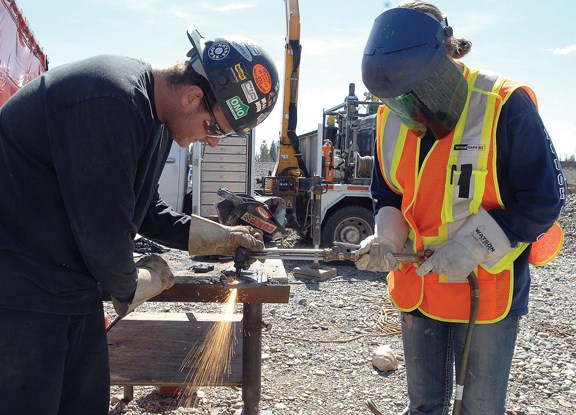Crane operator Jesse Fentie could identify with the high school students lifting loads Friday with his 90-tonne Link Belt machine and its 140-foot boom.
Two years ago, he was one of them, getting his first taste of operating heavy equipment in the Heavy Metal Rocks demonstration course.
Fentie showed enough interest to pursue a career with Sterling Crane and it got him a full-time job that pays him $50,000 a year. Not bad for a 19 year old and the paycheques are only going to get better. Once he completes his apprenticeship to become a journeyman, he could be making $60 per hour.
"My mindset used to be that you had to go to university to get a good-paying job," said Fentie. "I was going to start with getting a trade and going to college and I found out I could start working for a company first and get into an apprenticeship program.
"I tried out the cranes [two years ago at Heavy Metal Rocks] and I thought I did fairly well with them. Just after the program I knew I wanted to get into construction and I didn't know what that entailed. But the more I worked at it, the more I wanted it.
"This is a lot of fun, it's like being in a sandbox as a kid except now you're in a big sandbox with real toys."
Now in its ninth year, the four-day Heavy Metal Rocks event is a combined effort that involves local contractors, the Prince George Construction Association, School District 57, the College of New Caledonia and WorkSafe BC.
Each year, 32 students in Grades 11 and 12 are selected for the program, having met the criteria with their grades, attendance, a letter of application and an interview. Each student must complete an online safety course. Safety is stressed as a constant theme as students are given instruction on how to operate each piece of equipment, working in pairs for one hour at 16 stations set up in the Inland Concrete gravel pit.
They tried out cranes, bulldozers, graders, packers. loaders and excavators, learned how to drive rock trucks, and how to put up scaffolding. The equipment and fuel was supplied by local companies and the city.
"More than ever, employers are interested in engaging students," said Bruce Northrup, career program co-ordinator for School District 57. "I don't know if it's out of necessity, but this represents a lot of time, energy and money from these companies."
Rock truck/crane operator Scotty Raitt, now retired, says while there is no formal system in place to track students who went through Heavy Metal Rocks, a survey of last year's group found 25 per cent are either working in trades-related jobs or are in school to acquire a trade. He runs into them often when he visits construction sites.
"Given the projects that are on the books, the opportunities for heavy-equipment operators are huge," said Raitt. "We're very fortunate in Prince George because the construction industry as a family gets behind this Heavy Metal Rocks project."
Cole May is another young success story. A year ago, at age 21, he bought his own house and parks a 2011 Dodge 4 X4 pickup in the driveway. He's got plenty of work lined up as a welder forCentral Interior Piping. May started working while he was still a Grade 11 student at PGSS, arranging his classroom schedule so he could free up Fridays to work three days a week. He enrolled in the Career Technical Centre at CNC and 2 1/2 years later had his welder's ticket.
"I'm telling the students it's hard work, but there's always work available," said May. "A lot of them ask about the money, which is good, but you have to enjoy the work."
Five female students were among the group, an all-time high. Darcy O'Carroll, 17, a Grade 12 College Heights student, plans to study environmental engineering, but with so many jobs in trades expected in the expanding resource-based sectors, she's not sure what occupation she will choose.
"Environmental engineering has a role in construction and forestry and people say I would definitely find work in this industry," said O' Carroll. "I don't know if I'll actually do the operating, but I really like the machines, especially the dozers. It's all integrated. This gives you a basic understanding of how the machines work and gives you that experience so you can relate a little more with the workers."
Kalen Botel , 17, was back for his second Heavy Metal Rocks tour. Once he graduates this year from College Heights, he plans to work for a year to save some money then enroll in the power engineering program at CNC.
"It's fun trying out all the different equipment, it's hands-on, I don't like sitting at a desk in a cubicle," said Botel.
The students loved the excavator lent by Brandt Tractor and operator Adrien Tremblay, 69, was happy to share his 40 years of experience to show them how to work it.
"This is a brand-new machine with 18 hours on it, what more can you ask?" said Tremblay. "Them kids are lucky, they're learning on new stuff. When I learned, you had to monkey wrench it before you went to work.
"Us oldtimers are leaving. Some of them are older than me who are still in the field. If we don't teach those kids, where are they going to learn it? They have to be trained. What better place than here. I've been here since day one and I was a bit leery about putting a bunch of kids on equipment that size, but it's been no problem."



